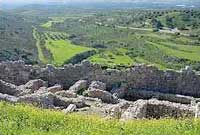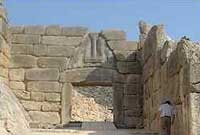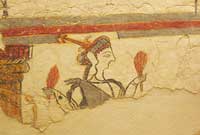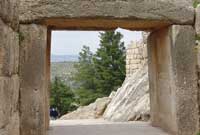 |
| Mycenae, the legendary home of the Atreides, is situated upon a small hill-top on the lower slopes of Euboea Mountain, between two of its peaks, on the road leading from the Argolic Gulf to the north (Corinth, Athens, etc.). The site was inhabited since Neolithic times (about 4000 BC) but reached its peak during the Late Bronze Age (1350-1200 BC), giving its name to a civilization which spread throughout the Greek world. |
|
 |
|
| During that period, the acropolis was surrounded by massive "cyclopean" walls which were built in three stages (ca.1350, 1250 and 1225 BC) except on its SE flank where a steep ravine provided natural defense. |
|
 |
|
A palace was built on the summit of the hill while towards the Argolic plain lay the wall - painted "Cult Center", the main gate or "Lion Gate" and "Grave Circle A" which contained the treasures now displayed at the National Archaeological Museum of Athens. On the NE side, a tunnel leading to a subterranean fountain was built in "cyclopean" masonry in around 1225 B.C. More tombs, "Grave Circle B", and large tholoi as well as houses were discovered outside the walls. |
|
| Mycenae was occupied without interruption until 468 B.C. when it was conquered by the city of Argos and its population banished. It was reoccupied in the 3rd century B.C. for a relatively short period. |
|
| It had been abandoned for some time when Pausanias visited the site during the 2nd century A.D. In 1841, K. Pittakis cleared the "Lion Gate" and in 1876, H. Schliemann started the excavations of the "Grave Circle A" which P. Stamatakis continued in 1877, bringing to light a sixth shaft grave. From 1864 to 1902, excavations at the palace, the subterranean fountain, and many chamber tombs were conducted by Ch. Tsountas while restricted excavations were also carried out by D. |
|
 |
|
| Evangelides in 1909, G. Rodenwaldt in 1911 and A. Keramopoulos in 1917. Further excavations were conducted by A.B. Wace during three campaigns, in 1920-1923 on the |
|
 |
|
acropolis and the tombs, in 1939 and 1950-1957 on the houses and tombs at the Lower City. Simultaneously, from 1952 to 1955 the Greek Archaeological Society under the direction of G. Mylonas and J. Papadimitriou investigated more houses as well as "Grave Circle B", while G. Mylonas and N. Verdelis uncovered more houses. Finally, the "Cult Center" was revealed by the British School of Archaeology under the direction of Lord |
|
| Taylour and was further investigated by G. Mylonas and Sp. Iakovides of the Greek Archaeological Society in 1959 and 1969-1974. |
|
| In 1950, the Restoration Service undertook works on the tomb of Clytemnestra, under the direction of An. Orlandos and E. Stikas. In 1954, E. Stikas consolidated and restored the megaron, the area south of the "Lion Gate", and the "Grave Circle B" and in 1955, the walls north of the "Lion Gate" as well as the courtyard of the palace. |
|
 |
|
|
 |
|
|
|
